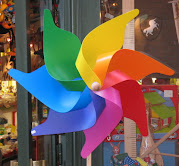


Dr B took these and other photos at a short ceremony at the end of the day around the two large pieces of the Berlin wall which are in the garden of the Ecumenical Centre. In the public park of Grand Saconnex a special sign was put up today to point the way to these pieces of the wall in the ecumenical garden. At the same time another sign was erected pointing in the opposite direction to a boat shaped commemoration by the Vietnamese community who were received by the commune of Grand Saconnex in the 1970s after fleeing across the seas.
The local Swiss authorities all turned up dressed in full regalia, I always find this rather wonderful and it made us smile to watch them walking through the car park and up to the pieces of the Berlin wall. It seemed right and Swiss and a good honouring of local democracy and civil society.
The WCC general secretary Olav Fykse Tveit welcomed the local authorities saying:
I'm old enough to have seen this wall in its former place in Berlin. One of the worst experiences of my life. It was a sign of what humanity should not be and should not do, to separate those who belong together.He then handed over to Jean Fischer who is a former general secretary of the Conference of European Churches and was in the at role when the wall was given to CEC. It's always interesting to compare what we thought we knew about the pieces of the wall with what Jean told us in his speech
I am grateful this wall is now in pieces and these pieces are signs of hope and of the future. They are signs that it is possible to make a difference.
We have a "prophetic role" to tear down what should be torn down and to "have a vision" This is our calling from God. To bring together what belongs together, to be one.
Jean ended by calling for walls of shame around the world to be brought down - from Mexico to Israel, from Belfast to Cyprus - both the physical walls of shame and the shameful walls of racism, exclusion and poverty.
I made a request to have two pieces of the wall the when in Berlin the week after the wall came down. Heard nothing for months and then got a telephone call from a colonel in the German army who said, your two pieces of the wall are here, please send a lorry to pick them up.
The wall was put up in 1961 but fell in several hours. The wall of shame and the Iron Curtain was destroyed. CEC had since WW2 tries to keep links between the free world and the Soviet ruled world.
There are new walls in Cyprus, in Ireland. A report in Le Monde from Belfast recounts how more and more walls are being put up to keep the communities apart. Never has the city been so calm, never has it been more divided. More and more people say "High walls make good neighbours".
More photos here.




































